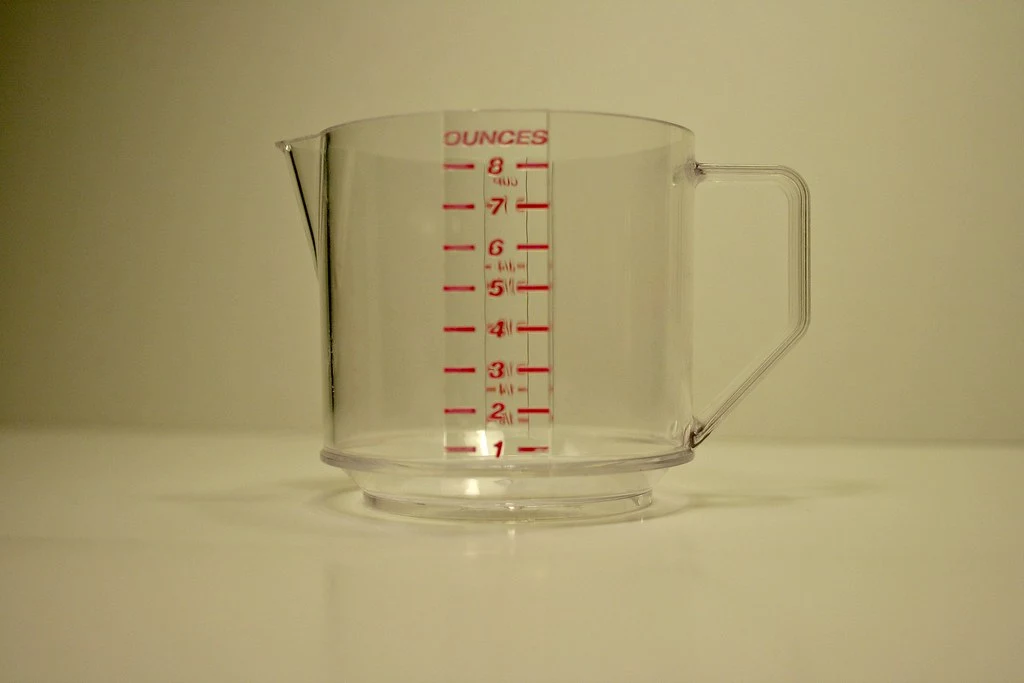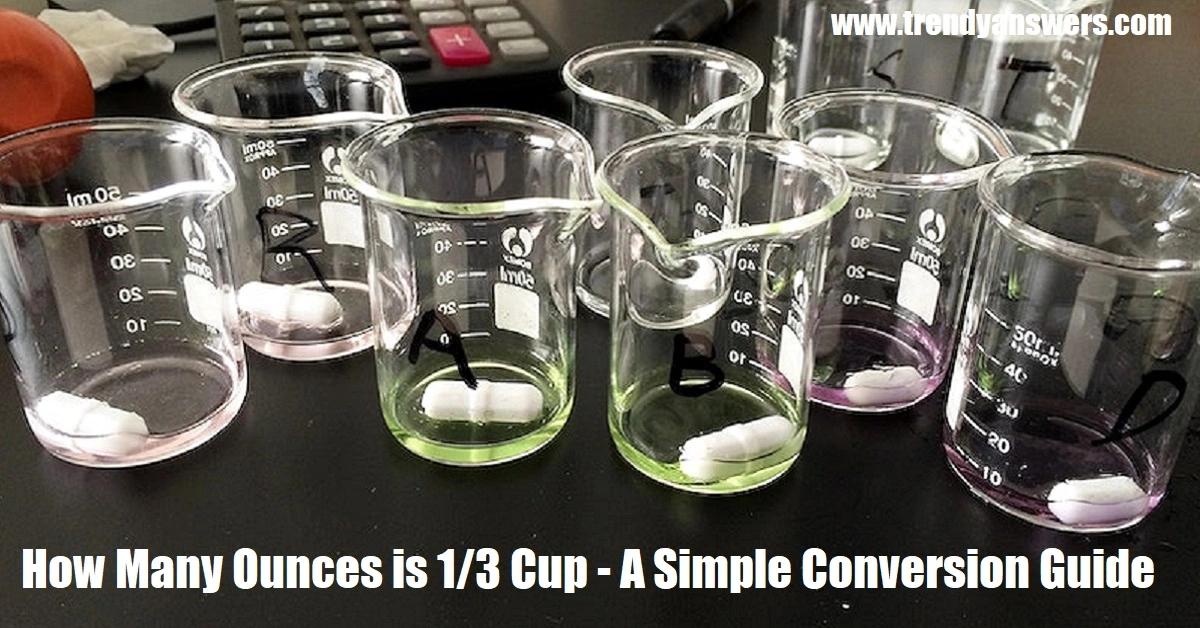Cooking and baking involve precise measurements to ensure the perfect outcome. However, converting measurements can sometimes be confusing, especially when you come across unfamiliar units or fractions. One common question that arises in the kitchen is, “How many ounces is 1/3 cup?” In this article, we will provide you with a simple conversion guide to help you accurately measure 1/3 cup in ounces and clear any confusion you may have regarding this particular measurement.

Understanding the Basics of Measurements
Before we dive into the specifics of converting 1/3 cup to ounces, let’s briefly discuss the basics of measurements in the culinary world. Two common units used in recipes are cups and ounces. Cups are used for measuring larger volumes, while ounces are employed for smaller quantities.
Also Read: How Much is 18 Cups in Ounces? The Ultimate Guide
Converting Cups to Ounces
Converting cups to ounces requires understanding the conversion factor between the two units. In the United States, a standard measuring cup has a capacity of 8 fluid ounces. Therefore, 1 cup is equivalent to 8 ounces. However, it’s important to note that this conversion applies to liquid measurements.
The Conversion of 1/3 Cup to Ounces
To convert 1/3 cup to ounces, we can use the previously mentioned conversion factor. Since 1 cup is equal to 8 ounces, we can calculate that 1/3 cup is approximately 2.67 ounces. However, it’s worth mentioning that this is an approximate value, as the precise conversion of 1/3 cup to ounces is 2.6667 ounces.
Practical Examples
To better understand the conversion of 1/3 cup to ounces, let’s explore a few practical examples:
- If a recipe calls for 1/3 cup of milk, you would need approximately 2.67 ounces of milk.
- When measuring 1/3 cup of flour, you would use approximately 2.67 ounces of flour.
- For 1/3 cup of sugar, the weight would be approximately 2.67 ounces.
Tips for Accurate Measurement
When measuring 1/3 cup, or any other measurement, it’s crucial to ensure accuracy. Here are a few tips to help you achieve precise measurements in your cooking and baking endeavors:
- Use a liquid measuring cup for liquid ingredients and a dry measuring cup for dry ingredients.
- Level off the ingredients with a straight edge to remove any excess.
- Position yourself at eye level with the measuring cup to avoid errors in measurement.
- Fill the cup slowly to prevent spillage or overflowing.
Also Read: How to calculate BMI in Rstudio
Adjusting Recipes with Precision
Knowing the conversion of 1/3 cup to ounces enables you to adjust recipes according to your needs. If you want to halve or double a recipe, you can calculate the appropriate measurements with ease. Understanding these conversions empowers you to experiment in the kitchen and achieve the desired taste and texture in your dishes.
Understanding Common Kitchen Measurements
Apart from cups and ounces, it’s helpful to familiarize yourself with other common kitchen measurements. Some commonly used units include teaspoons, tablespoons, quarts, and pounds. Expanding your knowledge of these measurements will make following recipes and converting units much simpler.
Converting Other Fractions of a Cup to Ounces
Converting other fractions of a cup to ounces follows a similar process. You can use the conversion factor of 1 cup equals 8 ounces to calculate the weight of any fraction. For example, 1/2 cup is equivalent to 4 ounces, and 1/4 cup is equal to 2 ounces.
Also Read: 1 Minute Plank is Equivalent to How Many Push-ups
Using Measurement Conversion Tools
In this digital age, numerous online tools and smartphone apps are available to assist you with measurement conversions. These tools allow you to convert between different units quickly and accurately. They can be particularly handy when dealing with complex recipes that require multiple conversions.
Also Read: How many liters equal a quarter cup? Ultimate Guide
Importance of Accuracy in Cooking and Baking
Accurate measurements play a vital role in the success of your culinary endeavors. A slight variation in the quantity of ingredients can significantly impact the taste, texture, and overall outcome of your dish. By understanding how to convert measurements accurately, you can ensure consistent results and enhance your cooking and baking skills.
Conclusion
Converting measurements in the kitchen, such as determining how many ounces are in 1/3 cup, may seem perplexing at first. However, armed with the knowledge and understanding of the conversion factor, you can confidently navigate through various recipes and achieve accurate results. Remember to measure ingredients carefully and utilize the appropriate tools when necessary. Cooking and baking are enjoyable experiences, and precise measurements are the key to culinary success.
Also Read: 7 Money Rules you didn’t learn in school
FAQs
- Q: Can I use a regular cup for measuring liquids and dry ingredients? A: No, it’s recommended to use separate measuring cups for liquid and dry ingredients. Liquid measuring cups usually have a spout and are designed for accurate liquid measurement, while dry measuring cups are meant for scooping and leveling off dry ingredients.
- Q: Is 2.67 ounces an exact conversion for 1/3 cup? A: No, 2.67 ounces is an approximate conversion. The precise conversion of 1/3 cup to ounces is 2.6667 ounces.
- Q: Are there any mobile apps available for measurement conversions? A: Yes, there are several mobile apps available for measurement conversions. Some popular ones include “Kitchen Calculator PRO,” “Convert Units for Free,” and “Unit Converter Ultimate.”
- Q: How can I ensure accurate measurements in my cooking and baking? A: To ensure accuracy, use proper measuring tools, level off ingredients, and follow the recipe instructions carefully. Taking your time and measuring with precision will yield the best results.
- Q: Why is it important to convert measurements accurately? A: Accurate measurements are crucial for achieving consistent results in cooking and baking. Precise measurements ensure that the dish turns out as intended and that the flavors, textures, and ratios of ingredients are well-balanced.
Also Read: How To Lose Weight Fast Safely – The Ultimate Guide
